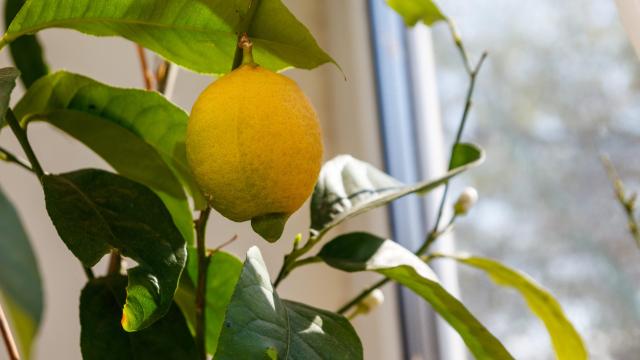Having your own lemon tree at home is often a luxury we assume is reserved for people who live in citrus-friendly locales. However, that doesn’t mean those in other regions can’t enjoy the simple pleasure of their own fresh-squeezed lemonade. With a little bit of attention, you can grow a lemon tree right inside your home.
Here’s how to grow and care for a lemon tree (without moving to Florida).
The best lemon trees to grow indoors
Lemon trees that thrive outside with a lot of room won’t do well in an enclosed environment, so it’s important to know the specifics about different breeds and their sizes. In general, a dwarf tree will be best for smaller spaces. Dwarf fruit trees can grow up to eight to ten feet tall in height, which is certainly bigger than your average house plant, but it’s smaller than the average lemon tree. Dwarf trees can also grow in pots and containers indoors, rather than ground soil, and they are easier to prune and their size is easier to maintain because the roots are shorter than other varieties. The best part: They reach maturity faster, so you’ll get fruit sooner than you expect.
Choosing the right kind of tree also depends on what type of taste you like and how much work you want to put into it. If you want a tree that requires less maintenance and produces lemons on the sweeter side, you should opt for a dwarf meyer lemon tree. Meyer lemons are a blend of sour lemons and sweet oranges, which make them a sweeter-than-an-average lemon. They can also survive without a great deal of heat and are easy to care for. Dwarf eureka lemons grow year-round but are more on the tart side. However, eureka lemon trees need a lot of light to thrive, so make sure it’s near a south-facing window if you choose to grow these lemons indoors.
How to choose the right planter pot for your lemon tree
The right planter pot is essential for the healthy growth of your lemon tree — and the most important element is its drainage holes. You don’t want the plant to sit in water because that can promote root rot. Terracotta pots are particularly good for drainage, but you can also use plastic or glazed pots with adequate drain holes.
Apartment Therapy recommends the planting pot be at least double the size of the root ball of the plant — that will give the roots enough room to grow and bear fruit. The soil should be a mix that drains well, too. If you make your own soil, Apartment Therapy suggests emulating their natural soil by mixing equal parts potting mix and sand.
Caring for an indoor lemon tree
Lemon trees grown indoors are in a different class of care than those outdoors. For example, as Gardening Know How explains, “If the variety of lemon you are growing normally has a hardiness zone of 7, in a container the lemon tree will have a hardiness zone of 8.” So, you’ll want to water and fertilize accordingly. Water at least two or three times a week — sometimes daily during growing seasons — and make sure to soak the plant enough that you see water escape through the drain holes. Keeping the plant moist (but not soaked) will give the roots the right amount of hydration to keep the leaves healthy; you should never let the plant dry out completely.
Fertiliser is another key element for your lemon tree. Planting company Pennington says that “lemon trees require plentiful nitrogen, as well as other essential nutrients, including magnesium and iron.” Fertilize every three to four months, making sure not to disturb the shallow roots, which can damage the plant.
How to know if your indoor lemon tree is struggling
There are signs to be aware of that your potted tree could be in danger. Look out for yellow leaves, which can be a sign of soggy roots (meaning the pot is not draining properly). You should also pay extra attention to your lemon tree in the winter months, as they are very susceptible to the cold.
You’ll also want to watch out for “sucker branches” that can begin growing at the root of the plant and taking over the tree — make sure to prune these as soon as you see them. If you follow these steps, you’ll have year-round juicy lemons.

Leave a Reply
You must be logged in to post a comment.